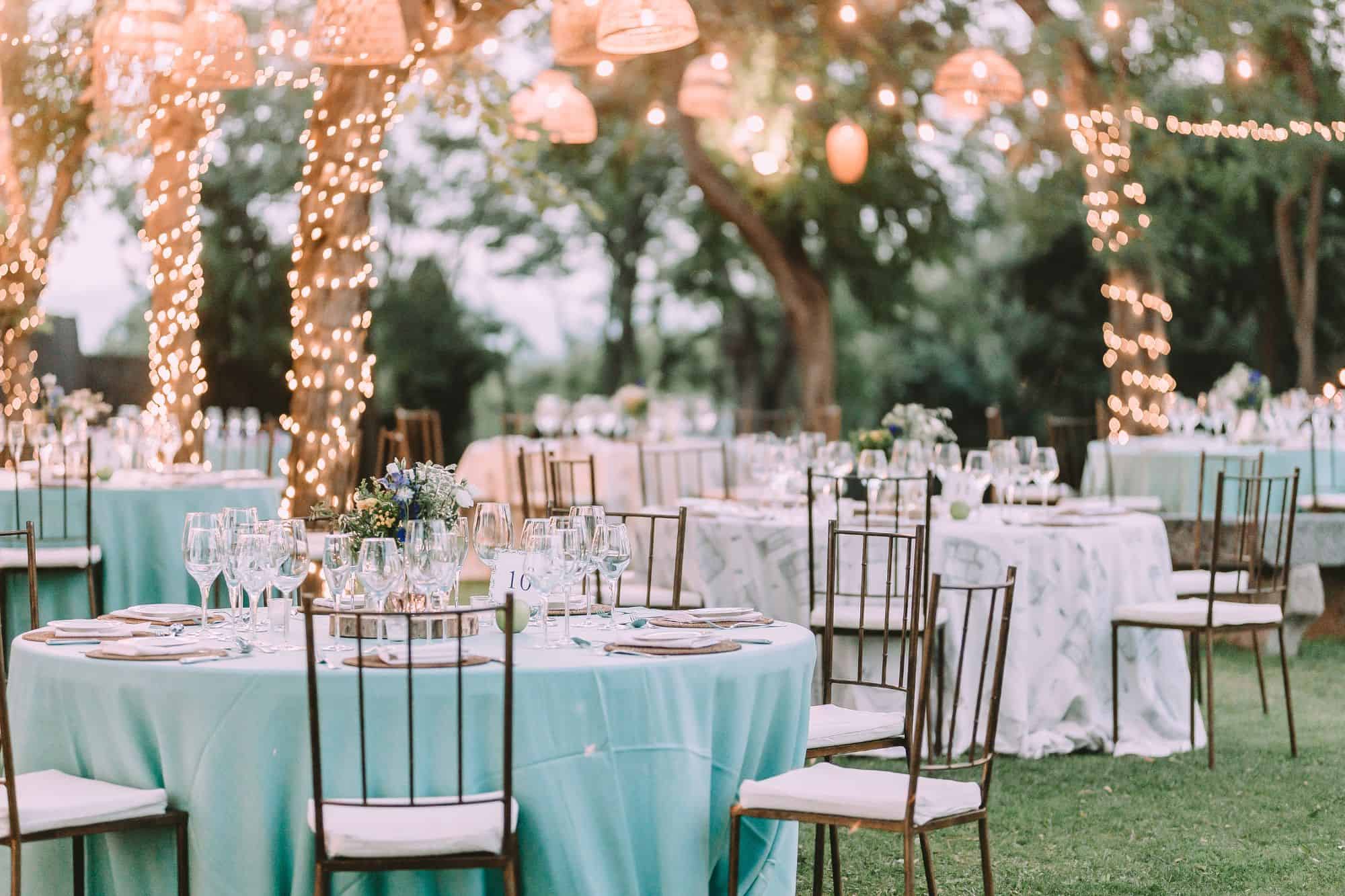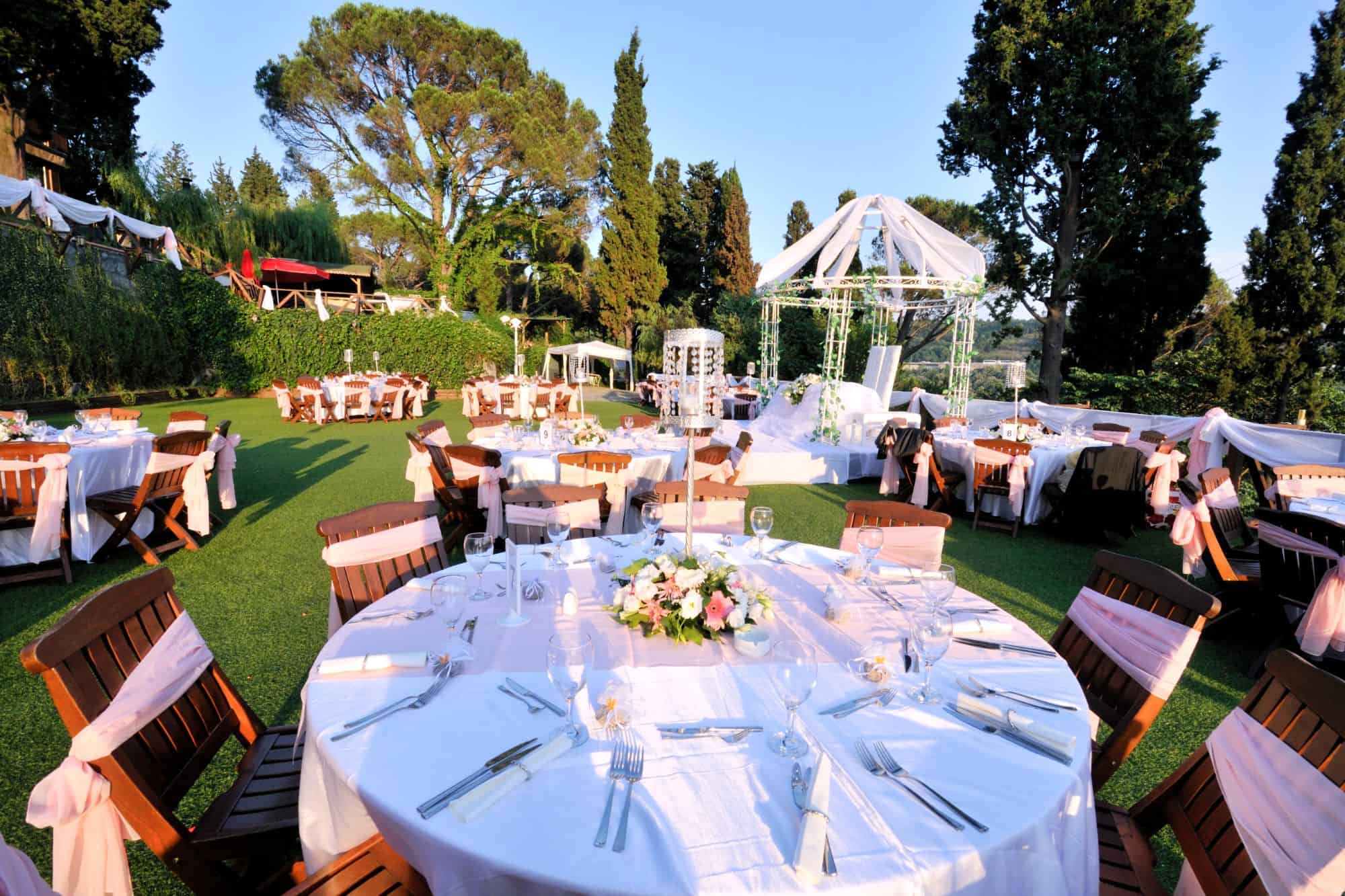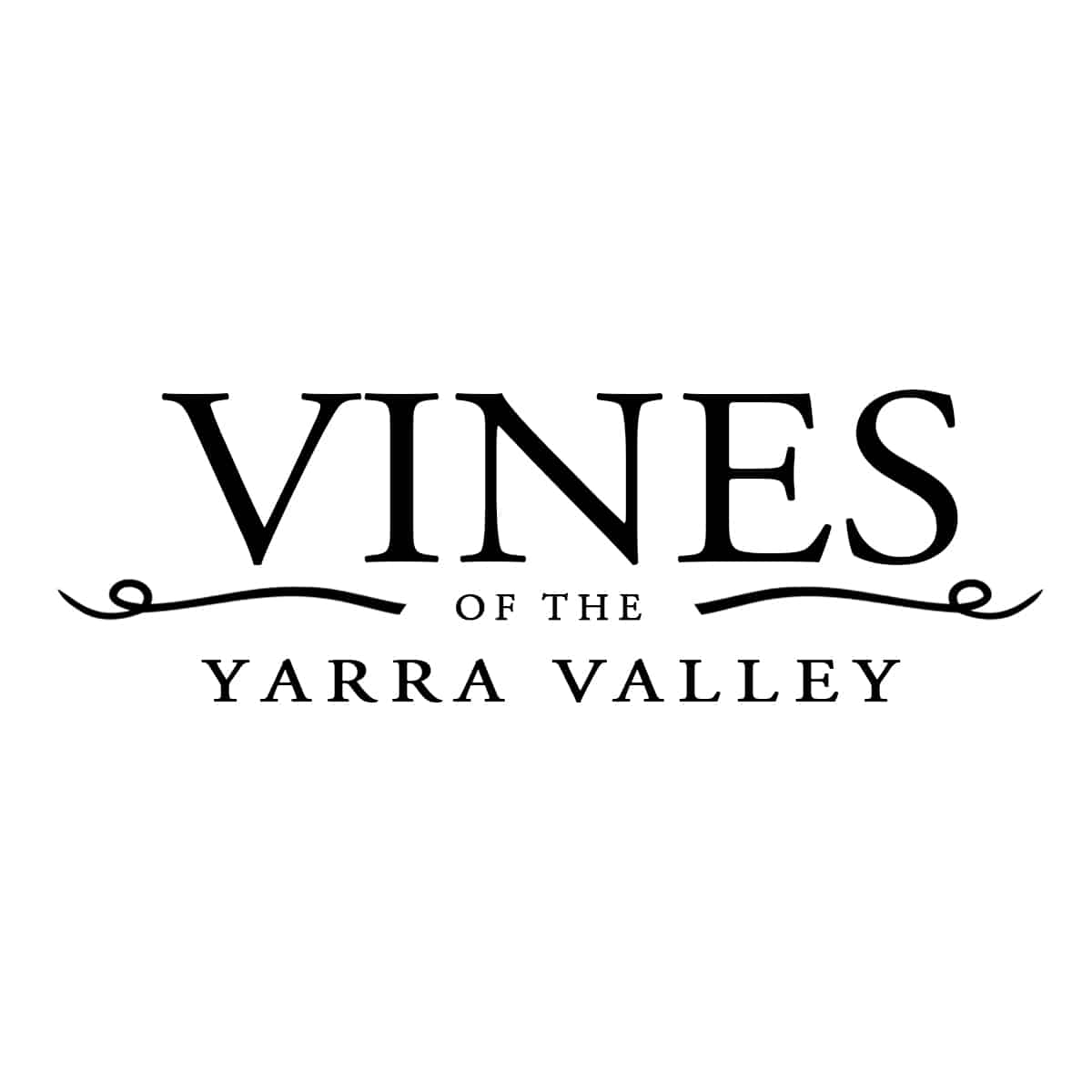Planning the table layout for an outdoor wedding is key to creating a functional, beautiful space for your guests.
The layout determines how people interact, enjoy the surroundings, and experience the event.
To design the perfect table arrangement, you’ll need to consider the venue’s natural elements, guest comfort, and the flow of movement.
This guide will help you plan an outdoor wedding table layout that is both practical and visually stunning.
Let’s get straight to the point
Planning an outdoor wedding table layout involves considering the natural landscape, choosing the right table shapes (round for intimacy, long for a communal feel), and ensuring clear pathways for guest movement.
Incorporate weather contingencies with tents or umbrellas and use lighting to enhance the atmosphere for evening events.
Balance aesthetics and practicality with appropriate centrepieces and durable table settings.
With careful planning, you can create a functional and beautiful layout that complements the outdoor setting and ensures guest comfort.
1. Consider the Venue’s Natural Landscape
When planning an outdoor wedding table layout, the first step is to evaluate your venue’s natural features.
The surroundings play a huge role in how you arrange your tables, ensuring that they complement rather than compete with the environment.
- Highlight Scenic Views: Arrange your tables to maximise the best views, whether it’s a waterfront, garden, or mountain backdrop. Guests should be able to enjoy these views from their seats.
- Work Around Natural Obstacles: Incorporate natural elements like trees, rocks, or flower beds into your layout. These features can act as natural dividers or focal points for the reception area.
- Level the Ground: If the terrain is uneven, choose flat areas for table placement to ensure guest comfort. Consider renting a platform if necessary to create a stable surface.
2. Choose the Right Table Shape and Size
The shape and size of your tables will define the feel and flow of the reception area. The choice should be influenced by the number of guests, the formality of the event, and the available space.
- Round Tables: Perfect for creating intimate conversations, round tables encourage interaction among guests seated close together. These are ideal for smaller, cozy gatherings or sections of the event where conversation is the focus.
- Rectangular Tables: Long tables create a communal, banquet-style atmosphere. This layout is particularly effective for larger groups and works well in open, spacious settings. It also suits weddings with family-style dining.
- Mixing Table Shapes: For a unique visual appeal, consider mixing round, square, and rectangular tables. This approach works well in non-traditional, relaxed wedding settings where the layout is more flexible.
3. Optimize Seating for Guest Interaction
Seating arrangements are critical in ensuring that guests feel comfortable and can engage with each other. The table layout should encourage easy socialisation while allowing space for movement.
- Close-Knit Seating: For an intimate atmosphere, seat guests at tables with fewer seats. Round tables with 6-8 guests encourage close conversations.
- Long Table Dynamics: Use long, rectangular tables if you want a communal vibe where guests can interact across the table. This layout is ideal for family-style meals and encourages mingling.
- Assigned Seating: Consider assigning seats to ensure that families, friends, and guests with specific preferences (like seating near the dance floor or away from high-traffic areas) are comfortably accommodated.
4. Plan for Flow and Accessibility
The table layout must account for easy movement, ensuring guests can navigate between tables, the dance floor, and key areas like the bar or buffet without congestion.
- Clear Pathways: Leave ample space between tables for guests and waitstaff to move freely. Ensure pathways lead directly to high-traffic areas like food stations, bars, and restrooms.
- Dance Floor Proximity: Place the tables close enough to the dance floor so guests feel connected to the action, but ensure there is enough space for dancing without bumping into seated guests.
- Buffet and Bar Placement: Position the buffet or bar far enough from the seating area to prevent crowding but within convenient walking distance. This allows guests to grab food or drinks without interrupting seated conversations.
5. Incorporate Weather Considerations
Outdoor weddings are at the mercy of weather, so it’s essential to plan your table layout with potential weather changes in mind.
- Tents for Protection: Renting tents or marquees can shelter guests from sun, wind, or unexpected rain. Arrange tables so that everyone is covered in case of poor weather.
- Shade and Sun Exposure: Consider how much sun the venue gets and how long guests will be outdoors. Place tables under natural or artificial shade, such as trees or umbrellas, to protect guests from direct sunlight.
- Wind Planning: If your venue is in a windy location, avoid lightweight tablecloths or decorations that could easily blow away. Secure centrepieces and use heavier materials for table settings.
6. Lighting for Evening Events
If your outdoor wedding extends into the evening, proper lighting becomes essential not just for ambience but for practical reasons, ensuring guests can see and navigate the space safely.
- Overhead String Lights: String lights or fairy lights hung above the tables can create a warm, inviting atmosphere and define the reception space.
- Lanterns and Candles: Place lanterns on tables or along pathways for a soft, romantic glow. LED candles offer a safe alternative for table centrepieces.
- Highlight Key Areas: Use focused lighting to highlight the dance floor, buffet area, or important natural features like trees or water elements.
7. Balancing Aesthetics with Practicality
While it’s important for your table layout to look beautiful, it should also be functional and comfortable for guests. Here’s how to strike the right balance:
- Centerpieces: Choose centerpieces that fit the outdoor theme, like flowers, greenery, or rustic elements. Make sure they aren’t too tall or obstructive, so guests can see each other across the table.
- Natural Décor: Incorporate elements from the environment into your design. For example, use wooden accents, potted plants, or natural stones that reflect the outdoor setting.
- Practical Table Settings: Ensure the table settings are weather-resistant. Use sturdy, non-breakable glassware and dishes if the wedding is on uneven ground or in a windy location.
8. Seating Arrangements Based on Venue Size and Guest Count
Your final table layout should efficiently utilise the space available without making guests feel cramped or too spread out.
- For Large Venues: Use longer tables to fill up open spaces. Break up the layout with lounge areas or additional décor elements like potted plants or hanging floral arrangements to prevent the space from feeling empty.
- For Small Venues: Stick to smaller, round tables to maximise space while ensuring guests still have room to move around. Consider compact, streamlined furniture that doesn’t overwhelm the area.
Conclusion
Planning an outdoor wedding table layout is about balancing beauty with practicality.
You can create a comfortable and stylish layout by considering the venue’s natural features, choosing the right table shapes and sizes, and optimising the seating for social interaction and movement.
Don’t forget to account for weather, lighting, and guest comfort to ensure a smooth, memorable celebration.
With careful planning, your outdoor wedding table layout will enhance the overall experience and create a beautiful setting for you and your guests.
Frequently Asked Questions
How Do I Choose The Best Table Shape And Arrangement For My Outdoor Wedding?
The choice of table shape and arrangement depends on your wedding’s overall theme, the space available, and the level of intimacy you wish to create.
Round tables are popular for encouraging conversation and are ideal for more traditional, formal weddings.
Rectangular tables can offer a more communal feel and work well for rustic or family-style settings.
Consider the layout of your outdoor space and how each table shape will fit within it; for example, if you have a long, narrow area, rectangular tables might fit better than round ones.
What Are The Key Considerations For Placing Tables Outdoors To Ensure Guest Comfort?
Consider factors like the sun’s direction, potential wind, and uneven ground when planning your outdoor table layout.
Position tables so guests aren’t facing directly into the sun during key moments like the ceremony or speeches.
If wind is a concern, avoid lightweight decorations that could easily blow away. Choose tables and chairs that can be adjusted or stabilised for uneven terrain to prevent wobbling.
How Can I Incorporate The Natural Landscape Into My Table Layout Plan?
Use the natural beauty of your venue as a backdrop for your tables. Arrange seating to maximise views of scenic highlights, like a waterfront, mountains, or flower gardens.
Consider the paths guests will take through the space and how you can guide them through the most beautiful areas.
If there are trees or other natural features, consider how tables can be arranged around them, possibly using their shade or incorporating them into your decor.
What Strategies Can I Use To Ensure All Guests Have A Good View During The Wedding?
To ensure everyone has a good view, especially during key moments like exchanging vows or toasts, consider elevating those areas or using a circular or semi-circular table arrangement around the focal point.
Avoid tall centrepieces that might block views across tables, and consider varying the height of decor elements to create visual interest without obstruction.
For larger weddings, screens or live feeds can be set up so guests seated further away can still see the action.
How Do I Handle The Challenge Of Unexpected Weather Changes For My Outdoor Wedding Table Layout?
Always have a backup plan for inclement weather. This could involve having a tent on standby, ready to be set up if the forecast turns, or choosing a venue with an indoor option that can accommodate your entire setup if needed.
When planning your layout, consider how quickly and easily tables and other elements can be moved indoors or under cover.
Additionally, consider using table decor and place settings that are secured against the wind, and have a plan for protecting or quickly moving any sensitive decorations.



